Metamorphic Age Comparison and Its Implications between the Zuoquan and Zanhuang Complexes in the Central North China Craton, Based on LA-ICP-MS Zircon U–Pb Dating
Abstract
1. Introduction
2. Geological Setting
3. Sample Selection and Analytical Methods
3.1. Sample Selection
3.2. Analytical Methods
4. Results
4.1. Zircon Dating of Samples in the Zuoquan Complex
4.1.1. Magnetite-Bearing Biotite–Hornblende Schist Sample
4.1.2. Magnetite–Hornblende–Quartz Schist Sample
4.1.3. Garnet-Bearing Hornblende–Biotite–Plagioclase Gneiss Samples
4.2. Zircon Dating of Samples in the Zanhuang Complex
5. Discussion
5.1. Characteristics of Metamorphic Zircons
5.2. Interpretation of Zircon U–Pb Dating
5.3. Tectonic Implications
6. Conclusions
Supplementary Materials
Author Contributions
Funding
Conflicts of Interest
References
- Wu, J.S.; Geng, Y.S.; Shen, Q.H.; Wan, Y.S.; Liu, D.Y.; Song, B. Archean Geological Characteristics and Tectonic Evolution of the Sino-Korean Ancient Super Continental; Geological Publishing House: Beijing, China, 1998; pp. 192–212. (In Chinese) [Google Scholar]
- Zhao, G.C.; Wilde, S.A.; Cawood, P.A.; Lu, L.Z. Thermal evolution of the Archaean basement rocks from the eastern part of the North China Craton and its bearing on tectonic setting. Int. Geol. Rev. 1998, 40, 706–721. [Google Scholar] [CrossRef]
- Zhao, G.C.; Sun, M.; Wilde, S.A.; Li, S.Z. Neoarchaean to Palaeoproterozoic evolution of the North China Craton: Key issues revisited. Precambrian Res. 2005, 136, 177–202. [Google Scholar] [CrossRef]
- Li, J.H.; Qian, X.L.; Huang, X.N.; Liu, S.W. Tectonic framework of North China Block and its cratonization in the early Precambrian. Acta Petrol. Sin. 2000, 16, 1–10, (In Chinese with English Abstract). [Google Scholar]
- Kusky, T.M.; Li, J.H. Paleoproterozoic tectonic evolution of the North China Craton. J. Asian Earth Sci. 2003, 22, 23–40. [Google Scholar] [CrossRef]
- Faure, M.; Trap, P.; Lin, W.; Monié, P.; Bruguier, O. The formation of the North China Craton by two Palaeoproterozoic continental collisions in Lüliang-Hengshan-Wutaishan-Fuping massifs. Episodes 2007, 30, 1–12. [Google Scholar] [CrossRef] [PubMed]
- Zhai, M.G. Cratonization and the Ancient North China Continent: A summary and review. Sci. China Earth Sci. 2011, 54, 1110–1120. [Google Scholar] [CrossRef]
- Zhai, M.G.; Santosh, M. The early Precambrian odyssey of the North China Craton: A synoptic overview. Gondwana Res. 2011, 20, 6–25. [Google Scholar] [CrossRef]
- Zhai, M.G.; Santosh, M. Metallogeny of the North China Craton: Link with secular changes in the evolving Earth. Gondwana Res. 2013, 24, 275–297. [Google Scholar] [CrossRef]
- Zhao, G.C.; Cawood, P.A.; Wilde, S.A.; Sun, M.; Zhang, J.; He, Y.H.; Yin, C.Q. Amalgamation of the North China Craton: Key issues and discussion. Precambrian Res. 2012, 222, 55–76. [Google Scholar] [CrossRef]
- Peng, P.; Wang, X.P.; Windley, B.F.; Guo, J.H.; Zhai, M.G.; Li, Y. Spatial distribution of ~ 1950–1800 Ma metamorphic events in the North China Craton: Implications for tectonic subdivision of the craton. Lithos 2014, 202, 250–266. [Google Scholar] [CrossRef]
- Xiao, L.L.; Liu, F.L.; Chen, Y. Metamorphic P-T-t paths of the Zanhuang metamorphic complex: Implications for the Paleoproterozoic evolution of the Trans-North China Orogen. Precambrian Res. 2014, 255, 216–235. [Google Scholar] [CrossRef]
- Xiao, L.L.; Liu, F.L. Precambrian metamorphic history of the metamorphic complexes in the Trans-North China Orogen, North China Craton. Acta Petrol. Sin. 2015, 31, 3012–3044, (In Chinese with English Abstract). [Google Scholar]
- Tang, L.; Santosh, M. Neoarchean-Paleoproterozoic terrane assembly and Wilson cycle in the North China Craton: An overview from the central segment of the trans-north china orogen. Earth Sci. Rev. 2018, 182, 1–27. [Google Scholar] [CrossRef]
- Chen, H.X.; Liu, J.H.; Zhang, Q.W.L.; Wang, H.Y.C.; Wu, C.M. A long-lived tectono-metamorphic event in the late Paleoproterozoic: Evidence from SIMS U–Th–Pb dating of monazite from metapelite in central-south Trans-North China Orogen. Precambrian Res. 2020, 336, 105497, in press. [Google Scholar] [CrossRef]
- Zhao, G.C.; Wilde, S.A.; Cawood, P.A.; Sun, M. Archean blocks and their boundaries in the North China Craton: Lithological, geochemical, structural and P-T path constraints and tectonic evolution. Precambrian Res. 2001, 107, 45–73. [Google Scholar] [CrossRef]
- Yang, C.H.; Du, L.L.; Ren, L.D.; Song, H.X.; Wan, Y.S.; Xie, H.Q.; Liu, Z.X. The age and petrogenesis of the Xuting Granite in the Zanhuang Complex, Hebei Province: Constraints on the structural evolution of the Trans-North China Orogen, North China Craton. Acta Petrol. Sin. 2011, 27, 1003–1016, (In Chinese with English Abstract). [Google Scholar]
- Jiang, Z.S.; Wang, G.D.; Xiao, L.L.; Diwu, C.R.; Lu, J.S.; Wu, C.M. Paleoproterozoic metamorphic P-T-t path and tectonic significance of the Luoning metamorphic complex at the southern terminal of the Trans-North China Orogen, Henan Province. Acta Petrol. Sin. 2011, 27, 3701–3717, (In Chinese with English Abstract). [Google Scholar]
- Wang, G.D.; Wang, H.; Chen, H.X.; Lu, J.S.; Xiao, L.L.; Wu, C.M. U-Pb Dating of Zircons from Metamorphic Rocks of the Taihua Metamorphic Complex, Mt. Huashan, Southern Margin of the Trans-North China Orogen. Acta Geol. Sin. 2012, 86, 1541–1551, (In Chinese with English Abstract). [Google Scholar]
- Wang, G.D.; Wang, H.; Chen, H.X.; Lu, J.S.; Wu, C.M. Metamorphic evolution and zircon U–Pb geochronology of the Mts. Huashan amphibolites: Insights into the Palaeoproterozoic amalgamation of the North China Craton. Precambrian Res. 2014, 245, 100–114. [Google Scholar] [CrossRef]
- Lu, J.S.; Wang, G.D.; Wang, H.; Chen, H.X.; Wu, C.M. Metamorphic PTt paths retrieved from the amphibolites, Lushan terrane, Henan Province and reappraisal of the Paleoproterozoic tectonic evolution of the Trans-North China Orogen. Precambrian Res. 2013, 238, 61–77. [Google Scholar] [CrossRef]
- Lu, J.S.; Wang, G.D.; Wang, H.; Chen, H.X.; Wu, C.M. Palaeoproterozoic metamorphic evolution and geochronology of the Wugang block, southeastern terminal of the Trans-North China Orogen. Precambrian Res. 2014, 251, 197–211. [Google Scholar] [CrossRef]
- Lu, J.S.; Wang, G.D.; Wang, H.; Chen, H.X.; Peng, T.; Wu, C.M. Zircon SIMS U–Pb geochronology of the Lushan terrane: Dating metamorphism of the southwestern terminal of the Palaeoproterozoic Trans-North China Orogen. Geol. Mag. 2015, 152, 367–377. [Google Scholar] [CrossRef]
- Lu, J.S.; Zhai, M.G.; Lu, L.S.; Wang, H.Y.C.; Chen, H.X.; Peng, T.; Wu, C.M.; Zhao, T.P. Metamorphic P–T–t path retrieved from metapelites in the southeastern Taihua metamorphic complex, and the Paleoproterozoic tectonic evolution of the southern North China Craton. J. Asian Earth Sci. 2017, 134, 352–364. [Google Scholar] [CrossRef]
- Qian, J.H.; Wei, C.J.; Zhou, X.W.; Zhang, Y.H. Metamorphic P–T paths and new zircon U–Pb age data for garnet–mica schist from the Wutai Group, North China Craton. Precambrian Res. 2013, 233, 282–296. [Google Scholar] [CrossRef]
- Qian, J.H.; Wei, C.J.; Clarke, G.L.; Zhou, X.W. Metamorphic evolution and Zircon ages of Garnet–orthoamphibole rocks in southern Hengshan, North China Craton: Insights into the regional Paleoproterozoic P–T–t history. Precambrian Res. 2015, 256, 223–240. [Google Scholar] [CrossRef]
- Qian, J.H.; Wei, C.J. P–T–t evolution of garnet amphibolites in the Wutai–Hengshan area, North China Craton: Insights from phase equilibria and geochronology. J. Metamorph. Geol. 2016, 34, 423–446. [Google Scholar] [CrossRef]
- Qian, J.H.; Yin, C.Q.; Wei, C.J.; Zhang, J. Two phases of Paleoproterozoic metamorphism in the Zhujiafang ductile shear zone of the Hengshan complex: Insights into the tectonic evolution of the North China Craton. Lithos 2019, 330, 35–54. [Google Scholar] [CrossRef]
- Chen, H.X.; Wang, J.; Wang, H.; Wang, G.D.; Peng, T.; Shi, Y.H.; Wu, C.M. Metamorphism and geochronology of the Luoning metamorphic terrane, southern terminal of the Palaeoproterozoic Trans-North China Orogen, North China Craton. Precambrian Res. 2015, 264, 156–178. [Google Scholar] [CrossRef]
- Zhang, H.F.; Wang, H.Z.; Santosh, M.; Zhai, M.G. Zircon U-Pb ages of Paleoproterozoic mafic granulites from the Huai’an terrane, North China Craton (NCC): Implications for timing of cratonization and crustal evolution history. Precambrian Res. 2016, 272, 244–263. [Google Scholar] [CrossRef]
- Zhang, Y.H.; Wei, C.J.; Lu, M.J.; Zhou, X.W. P–T–t evolution of the high-pressure mafic granulites from northern Hengshan, North China Craton: Insights from phase equilibria and geochronology. Precambrian Res. 2018, 312, 1–15. [Google Scholar] [CrossRef]
- Tang, L.; Santosh, M.; Tsunogae, T.; Koizumi, T.; Hu, X.K.; Teng, X.M. Petrology, phase equilibria modelling and zircon U–Pb geochronology of Paleoproterozoic mafic granulites from the Fuping complex, north China Craton. J. Metamorph. Geol. 2017, 35, 517–540. [Google Scholar] [CrossRef]
- Xiao, L.L.; Clarke, G.; Liu, F.L.; Wu, C.M. Discovery of mafic granulite in the Guandishan area of the Lüliang complex, North China Craton: Age and metamorphic evolution. Precambrian Res. 2017, 303, 604–625. [Google Scholar] [CrossRef]
- Xiao, L.L.; Clarke, G.; Liu, F.L.; Lu, J.S. Metamorphic records in the Lüliang metapelites of the Jiehekou Group: Implications for the tectonic evolution of the Trans-North China Orogen, North China Craton. Precambrian Res. 2019, 332, 105415. [Google Scholar] [CrossRef]
- Zhao, J.; Gou, L.; Zhang, C.; Guo, A.; Guo, X.; Liu, X. P–T–t path and tectonic significance of pelitic migmatites from the Lüliang complex in Xiyupi area of Trans-North China Orogen, North China Craton. Precambrian Res. 2017, 303, 573–589. [Google Scholar] [CrossRef]
- Liao, Y.; Wei, C.J. Ultrahigh-temperature mafic granulite in the Huai’an Complex, North China Craton: Evidence from phase equilibria modelling and amphibole thermometers. Gondwana Res. 2019, 76, 62–76. [Google Scholar] [CrossRef]
- Qian, J.H.; Wei, C.J.; Yin, C.Q. Paleoproterozoic P–T–t evolution in the Hengshan–Wutai–Fuping area, North China Craton: Evidence from petrological and geochronological data. Precambrian Res. 2017, 303, 91–104. [Google Scholar] [CrossRef]
- Wei, C.J.; Qian, J.H.; Zhou, X.W. Paleoproterozoic crustal evolution of the Hengshan–Wutai–Fuping region, North China Craton. Geosci. Front. 2014, 5, 485–497. [Google Scholar] [CrossRef]
- Wei, C.J. Paleoproterozoic metamorphism and tectonic evolution in Wutai-Hengshan region, Trans-North China Orogen. Earth Sci. 2018, 43, 24–43, (In Chinese with English abstract). [Google Scholar]
- Cheng, Y.Q.; Yang, C.H.; Wan, Y.S.; Liu, Z.X.; Zhang, X.P.; Du, L.L.; Zhang, S.G.; Wu, J.S.; Gao, J.F. The Early Precambrian Geology and the Reconstruction of Crustal Rocks Resulted by the Anatexis in Middle-Northern Segment of the Taihang Mountain; Geological Publishing House: Beijing, China, 2004; pp. 144–150. (In Chinese) [Google Scholar]
- Liu, S.W.; Lü, Y.J.; Feng, Y.G.; Zhang, C.; Tian, W.; Yan, Q.R.; Liu, X.M. Geology and Zircon U-Pb Isotopic Chronology of Dantazi Complex, Northern Hebei Province. Geol. J. China Univ. 2007, 13, 484–497, (In Chinese with English Abstract). [Google Scholar]
- Liu, D.Y.; Wilde, S.A.; Wan, Y.S.; Wang, S.Y.; Valley, J.W.; Kita, N.; Dong, C.Y.; Xie, H.Q.; Yang, C.X.; Zhang, Y.X.; et al. Combined U-Pb, hafnium and oxygen isotope analysis of zircons from meta-igneous rocks in the southern North China Craton reveal multiple events in the Late Mesoarchean-Early Neoarchean. Chem. Geol. 2009, 261, 140–154. [Google Scholar] [CrossRef]
- Xiao, L.L.; Liu, F.L.; Zhang, J. Records and its geological implication of metamorphic ages of ca. 2.5 Ga and ca. 1.9 Ga from the Zuoquan metamorphic complex in the Trans-North China Orogen. Acta Petrol. Sin. 2019, 35, 969–988, (In Chinese with English Abstract). [Google Scholar]
- Zhang, F.; Wang, Y.B.; Yang, C.H.; Du, L.L.; Yuan, H.Q. Shrimp U-Pb zircon dating of clastic sedimentary rocks of the Guandu Group, Zanhuang Complex, Hebei Province, and its geological significance. Geol. Bull. China 2019, 38, 1335–1343, (In Chinese with English Abstract). [Google Scholar]
- Zhang, F.; Wang, Y.B.; Du, L.L.; Yang, C.H.; Ayers, J.C.; Yuan, H.Q. The Neoarchean-Paleoproterozoic volcanic-sedimentary rocks in the Zanhuang Complex, North China Craton: Petrogenesis and implications for tectonic evolution. Precambrian Res. 2019, 328, 64–80. [Google Scholar] [CrossRef]
- Xiao, L.L.; Wu, C.M.; Zhao, G.C.; Guo, J.H.; Ren, L.D. Metamorphic P-T paths of the Zanhuang amphibolitic gneisses and metapelitic gneisses: Constraints on the tectonic evolution of the Paleoproterozoic Trans-North China Orogen. Int. J. Earth Sci. 2011, 100, 717–739. [Google Scholar] [CrossRef]
- Xiao, L.L.; Wang, G.D.; Wang, H.; Jiang, Z.S.; Diwu, C.R.; Wu, C.M. Zircon U–Pb geochronology of the Zanhuang metamorphic complex: Reappraisal of the Palaeoproterozoic amalgamation of the Trans-North China Orogen. Geol. Mag. 2013, 150, 756–764. [Google Scholar] [CrossRef]
- Wang, Y.J.; Fan, W.M.; Guo, F.; Li, C.W. Biotite 40Ar/39Ar geochronology of the deformational rocks from Zanhuang metamorphic domain in southern Taihang mountains and their tectonothermal overprinting. Acta Petrol. Sin. 2003, 19, 131–140, (In Chinese with English Abstract). [Google Scholar]
- Wang, Y.J.; Fan, W.M.; Zhang, Y.; Guo, F. Structural evolution and 40Ar/39Ar dating of the Zanhuang metamorphic domain in the North China Craton: Constraints on Paleoproterozoic tectonothermal overprinting. Precambrian Res. 2003, 122, 159–182. [Google Scholar] [CrossRef]
- Trap, P.; Faure, M.; Lin, W.; Monié, P.; Meffre, S.; Melletton, J. The Zanhuang Massif, the second and eastern suture zone of the Paleoproterozoic Trans-North China Orogen. Precambrian Res. 2009, 172, 80–98. [Google Scholar] [CrossRef]
- Ning, W.B.; Wang, J.P.; Xiao, D.; Li, F.F.; Huang, B.; Fu, D. Electron Probe Microanalysis of Monazite and Its Applications to U-Th-Pb Dating of Geological Samples. J. Earth Sci. 2019, 30, 952–963. [Google Scholar] [CrossRef]
- HBGMR. Regional Geology of Beijing, Tianjin and Heibei Province; Geology Publishing House: Beijing, China, 1989; pp. 16–30. (In Chinese) [Google Scholar]
- Yang, C.H.; Du, L.L.; Ren, L.D.; Song, H.X.; Wan, Y.S.; Xie, H.Q.; Geng, Y.S. Delineation of the ca. 2.7 Ga TTG gneisses in the Zanhuang Complex, North China Craton and its geological implications. J. Asian Earth Sci. 2013, 72, 178–189. [Google Scholar] [CrossRef]
- Du, L.L.; Yang, C.H.; Wyman, D.A.; Nutman, A.P.; Lu, Z.L.; Song, H.X.; Zhao, L.; Geng, Y.S.; Ren, L.D. Age and depositional setting of the Paleoproterozoic Gantaohe Group in Zanhuang Complex: Constraints from zircon U–Pb ages and Hf isotopes of sandstones and dacite. Precambrian Res. 2016, 286, 59–100. [Google Scholar] [CrossRef]
- Liu, C.H.; Zhao, G.C.; Sun, M.; Liu, F.L.; Zhang, J.; Yin, C.Q. Zircons U-Pb and Lu-Hf isotopic and whole-rock geochemical constraints on the Gantaohe Group in the Zanhuang Complex: Implications for the tectonic evolution of the Trans-North China Orogen. Lithos 2012, 146, 80–92. [Google Scholar] [CrossRef]
- Xiao, L.L.; Jiang, Z.S.; Wan, G.D.; Wan, Y.S.; Wang, T.; Wu, C.M. Metamorphic reactions and metamorphic P-T paths of the Precambrian metamorphic complex, Zanhuang, Hebei, north China. Acta Petrol. Sin. 2011, 27, 980–1002, (In Chinese with English Abstract). [Google Scholar]
- Xiao, L.L.; Liu, F.L.; Xie, Y.L.; Wu, C.M. Precambrian metamorphic evolution and its tectonic implications of the Zuoquan metamorphic complex. Acta Petrol. Sin. 2014, 30, 2925–2940, (In Chinese with English Abstract). [Google Scholar]
- Ernst, W.G. Tectonic history of subduction zones inferred from retrograde blueschist P-T paths. Geology 1988, 16, 1081–1084. [Google Scholar] [CrossRef]
- Brown, M. P-T-t evolution of orogenic belts and the causes of regional metamorphism. J. Geol. Soc. 1993, 150, 227–241. [Google Scholar] [CrossRef]
- Li, S.S.; Santosh, M.; Teng, X.M.; He, X.F. Paleoproterozoic arc-continent collision in the North China Craton: Evidence from the Zanhuang Complex. Precambrian Res. 2016, 286, 281–305. [Google Scholar] [CrossRef]
- Tang, L.; Santosh, M.; Tsunogae, T.; Maruoka, T. Paleoproterozoic meta-carbonates from the central segment of the Trans-North China Orogen: Zircon U–Pb geochronology, geochemistry, and carbon and oxygen isotopes. Precambrian Res. 2016, 284, 14–29. [Google Scholar] [CrossRef]
- Xiao, L.L.; Liu, F.L.; Zhang, J. Response to the early Neoarchean tectono-thermal events in the North China Craton: Evidence of ca. 2.7 Ga TTG gneisses from the Zuoquan metamorphic complex. Acta Petrol. Sin. 2019, 32, 325–348, (In Chinese with English Abstract). [Google Scholar]
- Yang, C.H.; Du, L.L.; Ren, L.D.; Song, H.X.; Wan, Y.S.; Xie, H.Q.; Liu, Z.X. Petrogenesis and geodynamic setting of the Jiandeng potassic granite at the end of the neoarchean in the Zanhuang complex, north China craton. Earth Sci. Front. 2011, 18, 62–78, (In Chinese with English Abstract). [Google Scholar]
- Song, H.X.; Yang, C.H.; Du, L.L.; Ren, L.D.; Geng, Y.S. Delineation of the ~ 2.7 Ga TTG gneisses in Zanhuang Complex, Heibei Province, and its geological significance. Acta Petrol. Sin. 2018, 34, 1599–1611, (In Chinese with English Abstract). [Google Scholar]
- Wiedenbeck, M.; Alle, P.; Corfu, F.; Griffin, W.L.; Meier, M.; Oberli, F.; Quadt, A.V.; Roddick, J.C.; Speigel, W. Three natural zircon standards for U–Th–Pb, Lu–Hf, trace element and REE analyses. Geostand. Newsl. 1995, 19, 1–23. [Google Scholar] [CrossRef]
- Jackson, S.E.; Pearson, N.J.; Griffin, W.L.; Belousova, E.A. The application of laser ablation-inductively coupled plasma-mass spectrometry to in situ U–Pb zircon geochronology. Chem. Geol. 2004, 211, 47–69. [Google Scholar] [CrossRef]
- Ludwig, K.R. Isoplot 3.0—A Geochronological Toolkit for Microsoft Excel; (Berkeley Geochronology Center, Special Publication; No. 4); Berkeley Geochronology Center: Berkeley, CA, USA, 2003; pp. 1–70. [Google Scholar]
- Corfu, F.; Hanchar, J.M.; Hoskin, P.W.O.; Kinny, P. Atlas of zircon textures. Rev. Mineral. Geochem. 2003, 53, 469–500. [Google Scholar] [CrossRef]
- Hoskin, P.W.O.; Schaltegger, U. The composition of zircon and igneous and metamorphic petrogenesis. Rev. Mineral. Geochem. 2003, 53, 27–62. [Google Scholar] [CrossRef]
- Harley, S.L.; Kelly, N.M.; Moller, A. Zircon behaviour and the thermal histories of mountain chains. Elements 2007, 3, 25–30. [Google Scholar] [CrossRef]
- Taylor, R.J.M.; Kirkland, C.L.; Clark, C. Accessories after the facts: Constraining the timing, duration and conditions of high-temperature metamorphic processes. Lithos 2016, 264, 239–257. [Google Scholar] [CrossRef]
- Rubatto, D. Zircon: The Metamorphic Mineral. Rev. Mineral. Geochem. 2017, 83, 261–295. [Google Scholar] [CrossRef]
- Rubatto, D.; Hermann, J. Zircon behaviour in deeply subducted rocks. Elements 2007, 3, 31–35. [Google Scholar] [CrossRef]
- Hoskin, P.W.O.; Black, L.P. Metamorphic zircon formation by solid-state recrystallization of protolith igneous zircon. J. Metamorph. Geol. 2000, 18, 423–439. [Google Scholar] [CrossRef]
- Hermann, J.; Rubatto, D. Relating zircon and monazite domains to garnet growth zones: Age and duration of granulite facies metamorphism in the Val Malenco lower crust. J. Metamorph. Geol. 2003, 21, 833–852. [Google Scholar] [CrossRef]
- McKay, G.; Le, L.; Wagstaff, J.; Crozaz, G. Experimental partitioning of rare earth elements and strontium: Constraints on petrogenesis and redox conditions during crystallization of Antarctic angrite Lewis Cliff 86010. Geochim. Cosmochim. Acta 1994, 58, 2911–2919. [Google Scholar] [CrossRef]
- Vavra, G.; Gebauer, D.; Schmidt, R.; Compston, W. Multiple zircon growth and recrystallization during polyphase Late Carboniferous to Triassic metamorphism in granulites of the Ivrea Zone (Southern Alps): An ion microprobe (SHRIMP) study. Contrib. Mineral. Petrol. 1996, 122, 337–358. [Google Scholar] [CrossRef]
- Schaltegger, U.; Fanning, C.M.; Günther, D.; Maurin, J.C.; Schulmann, K.; Gebauer, D. Growth, annealing and recrystallization of zircon and preservation of monazite in high-grade metamorphism: Conventional and in-situ U–Pb isotope, cathodoluminescence and microchemical evidence. Contrib. Mineral. Petrol. 1999, 134, 186–201. [Google Scholar] [CrossRef]
- Kelly, N.; Harley, S. An integrated microtextural and chemical approach to zircon geochronology: Refining the Archean history of the Napier Complex, east Antarctica. Contrib. Mineral. Petrol. 2005, 149, 57–84. [Google Scholar] [CrossRef]
- Li, Z.; Wei, C.J.; Zhang, S.W.; Yang, C.; Duan, Z.Z. Neoarchean granitoid gneisses in Eastern Hebei, North China Craton: Revisited. Precambrian Res. 2019, 324, 62–85. [Google Scholar] [CrossRef]
- Zhao, G.; Cawood, P.A.; Wilde, S.A.; Sun, M. Review of global 2.1–1.8 Ga orogens: Implications for a pre-Rodinia supercontinent. Earth Sci. Rev. 2002, 59, 125–162. [Google Scholar] [CrossRef]
- MacDonald, J.; Wheeler, J.; Goodenough, K.; Harley, S.; Crowley, Q.; Mariani, E. Combined SIMS U–Pb ages and Ti-in-zircon geothermometry fingerprints long deep crustal residence in the Archaean. Mineral. Mag. 2011, 75, 1377. [Google Scholar]
- Jamieson, R.A.; Beaumont, C. Coeval thrusting and extension during lower crustal ductile flow-implications for exhumation of high-grade metamorphic rocks. J. Metamorph. Geol. 2011, 29, 33–51. [Google Scholar] [CrossRef]
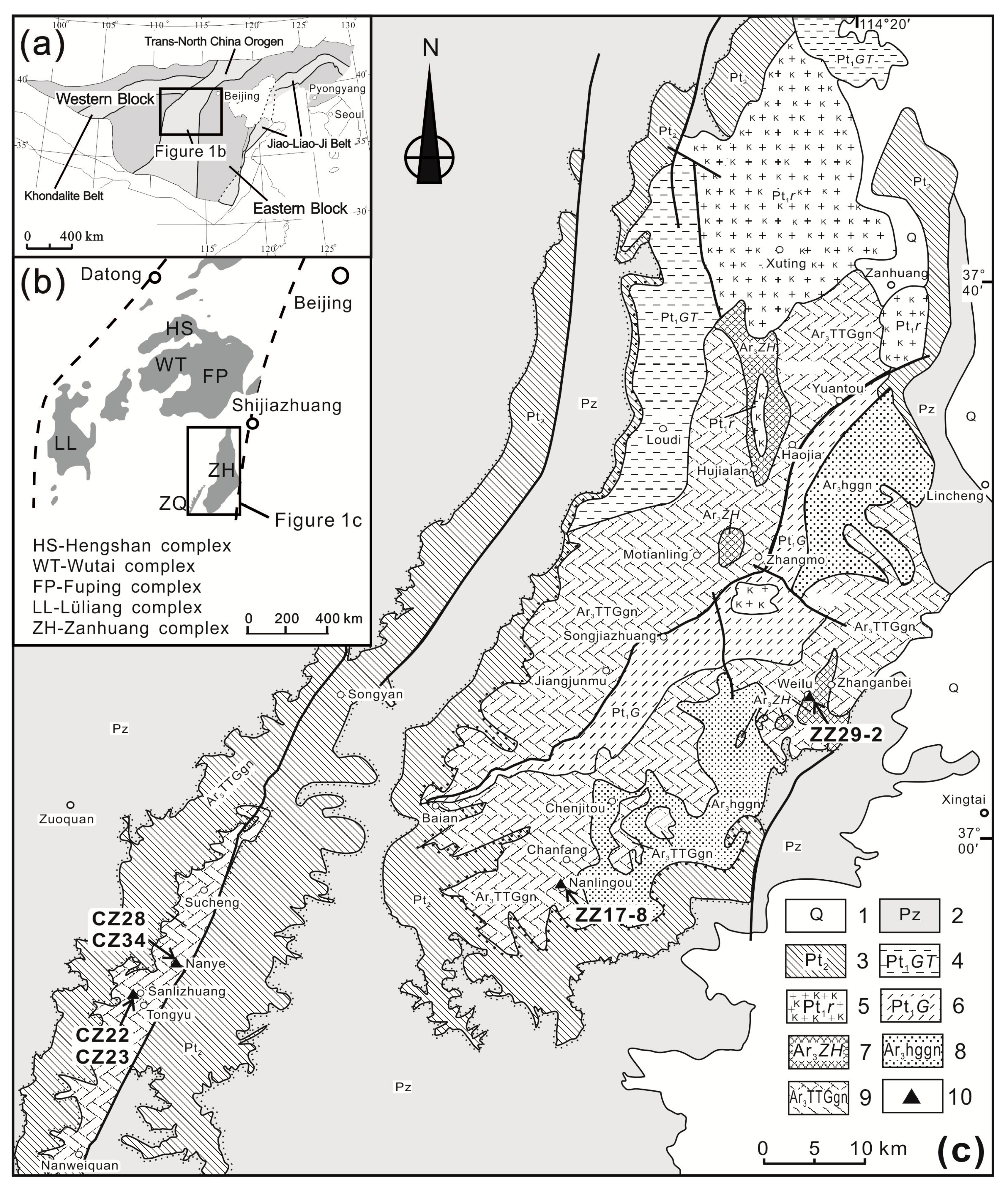
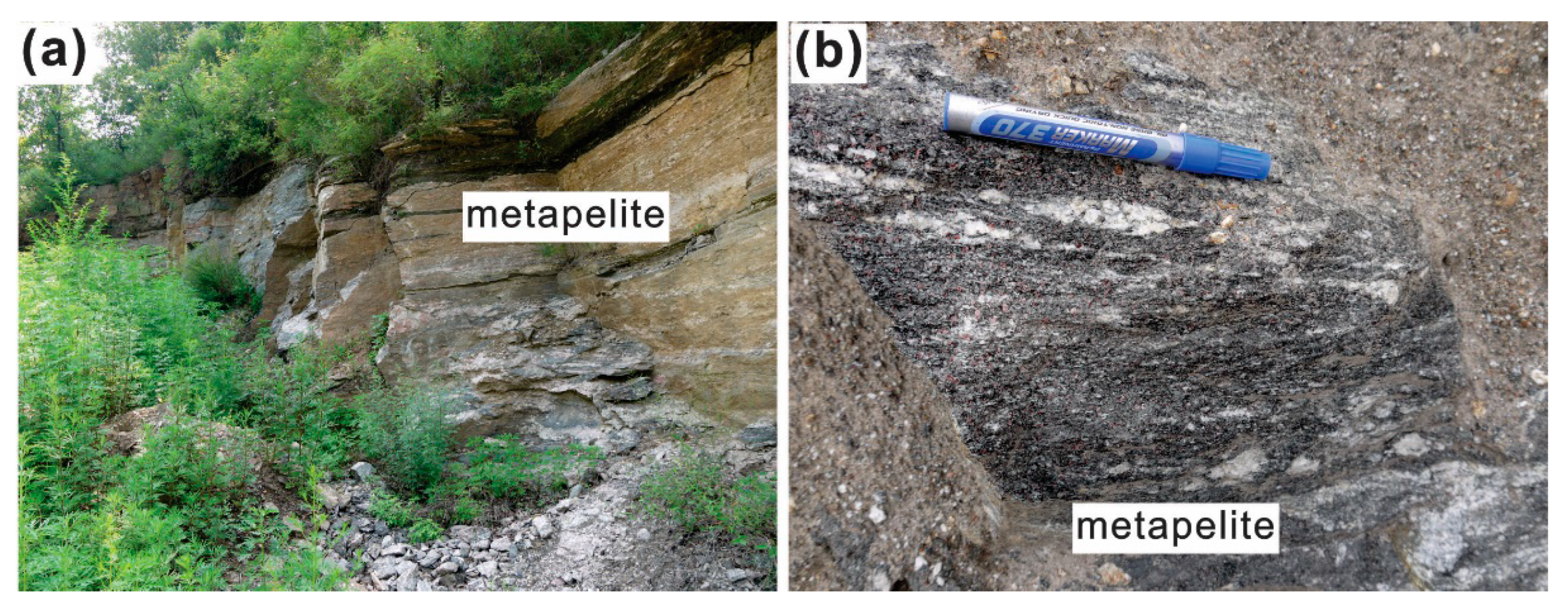
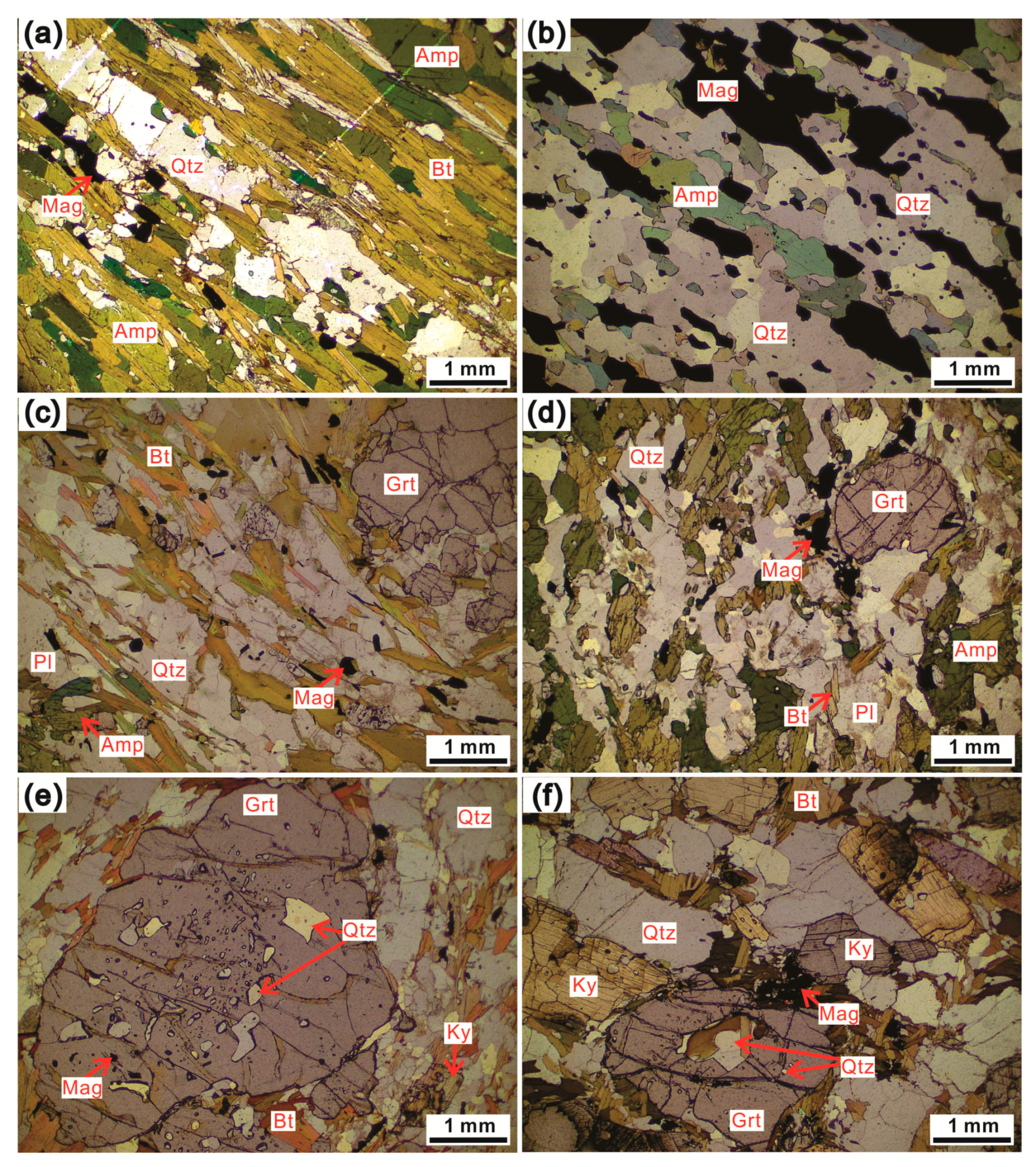
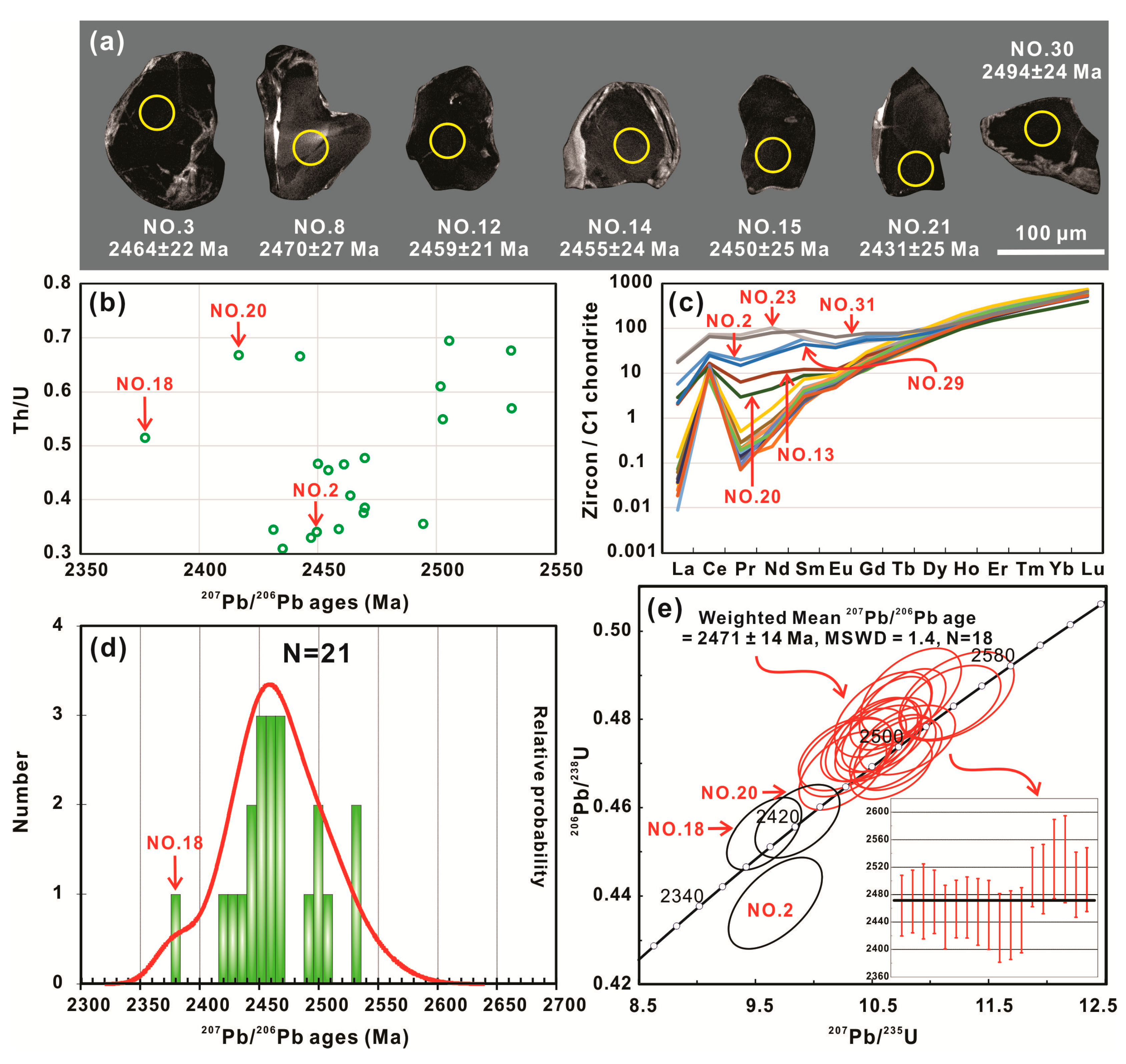
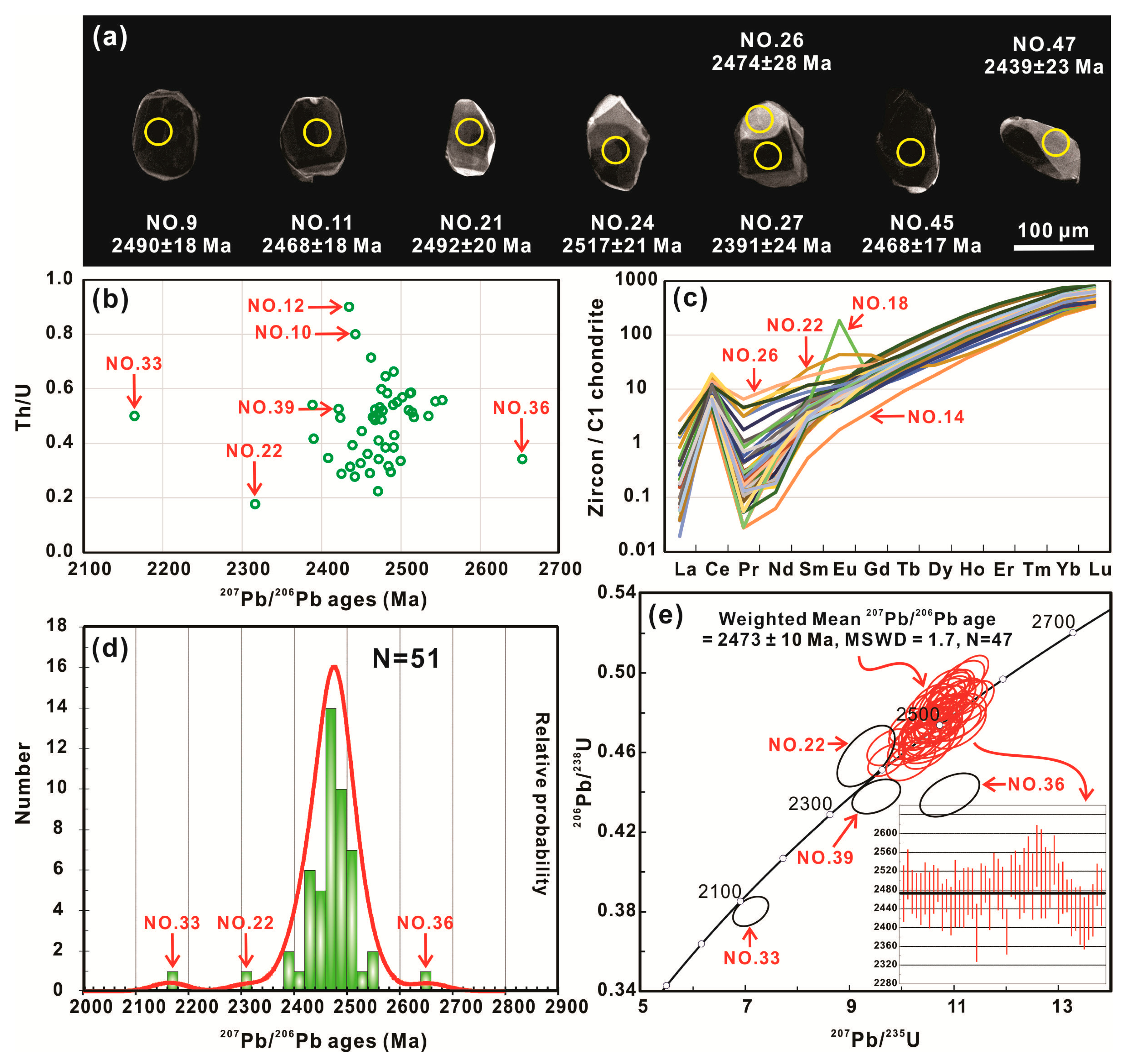
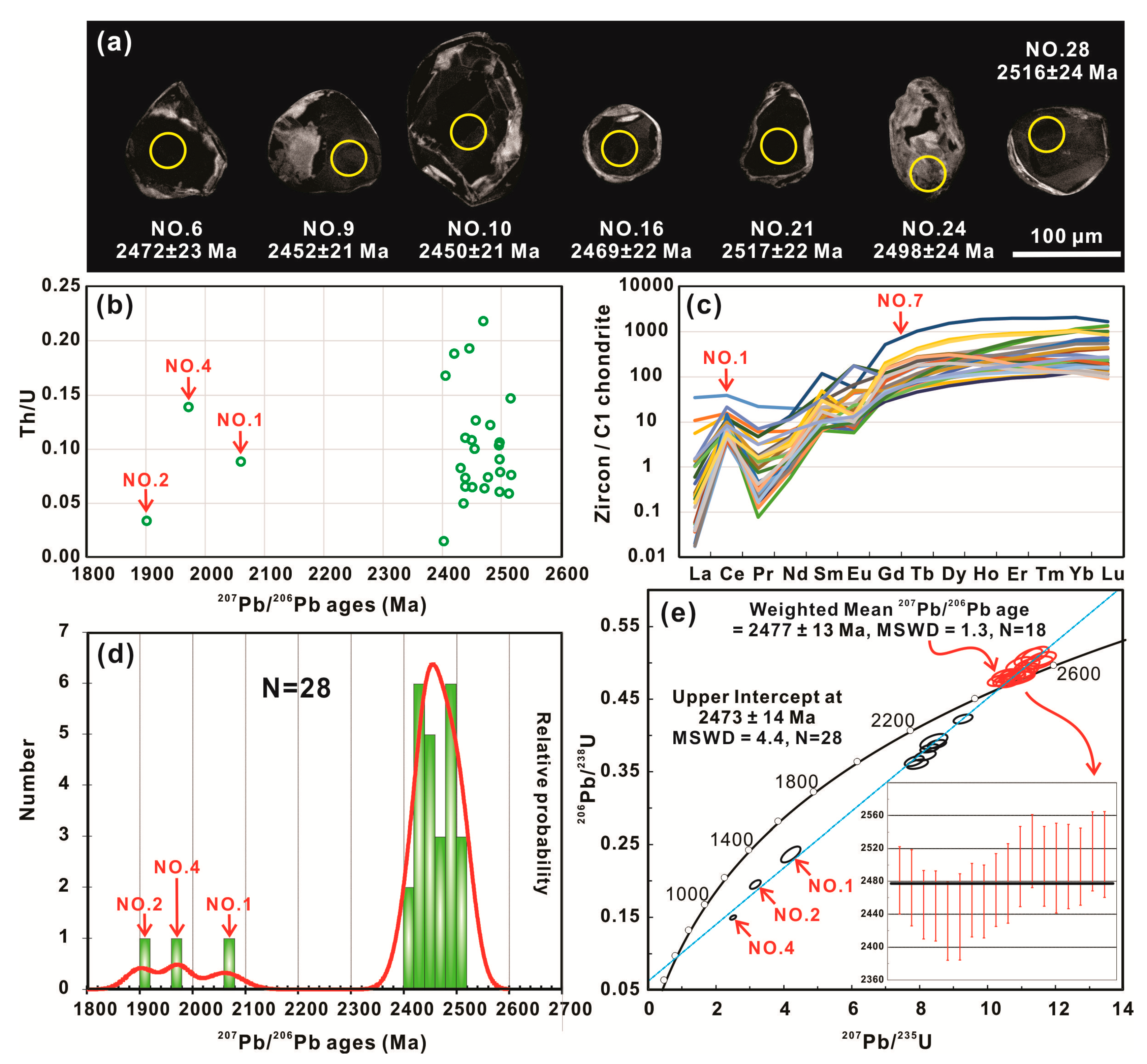
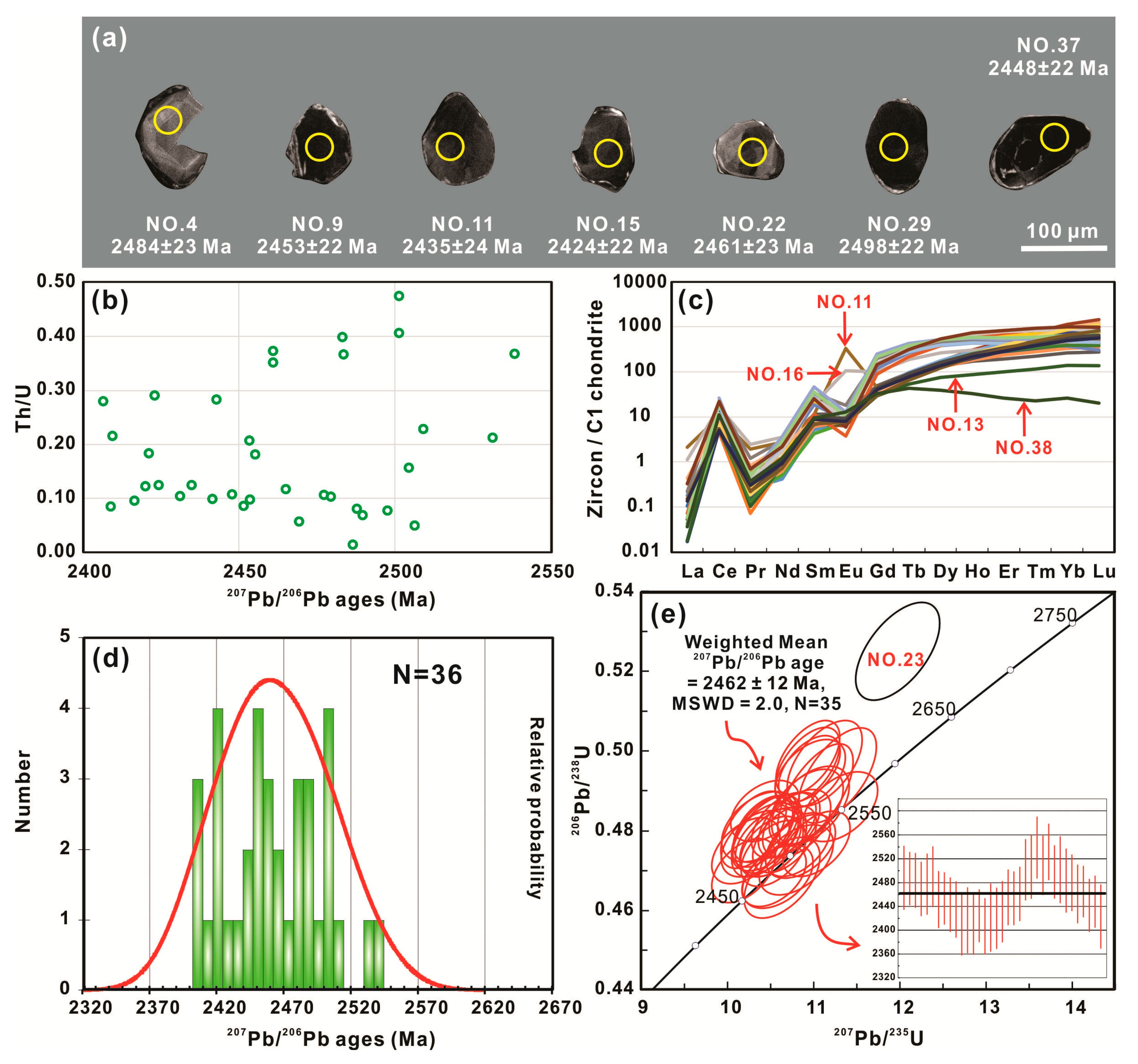
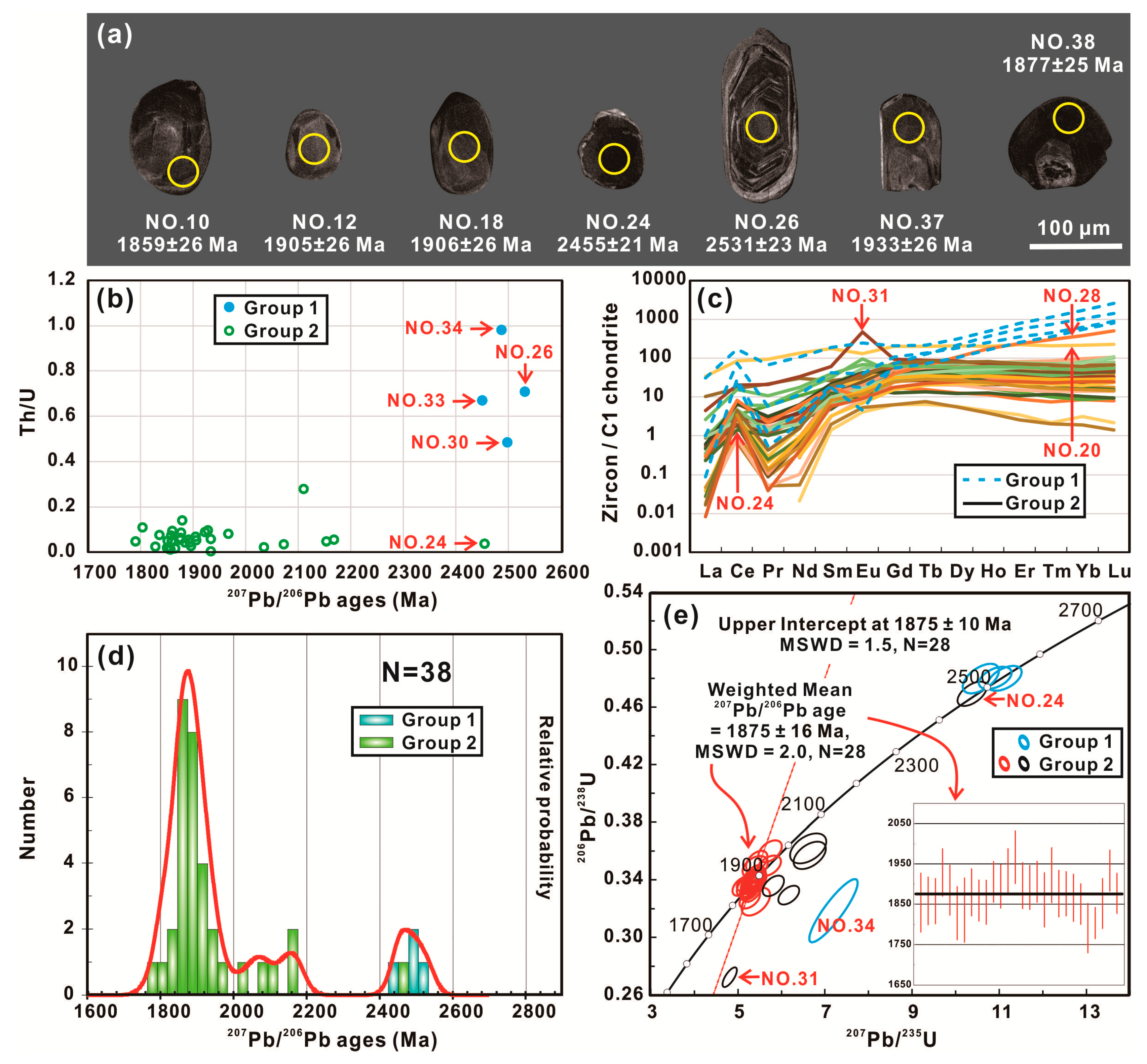
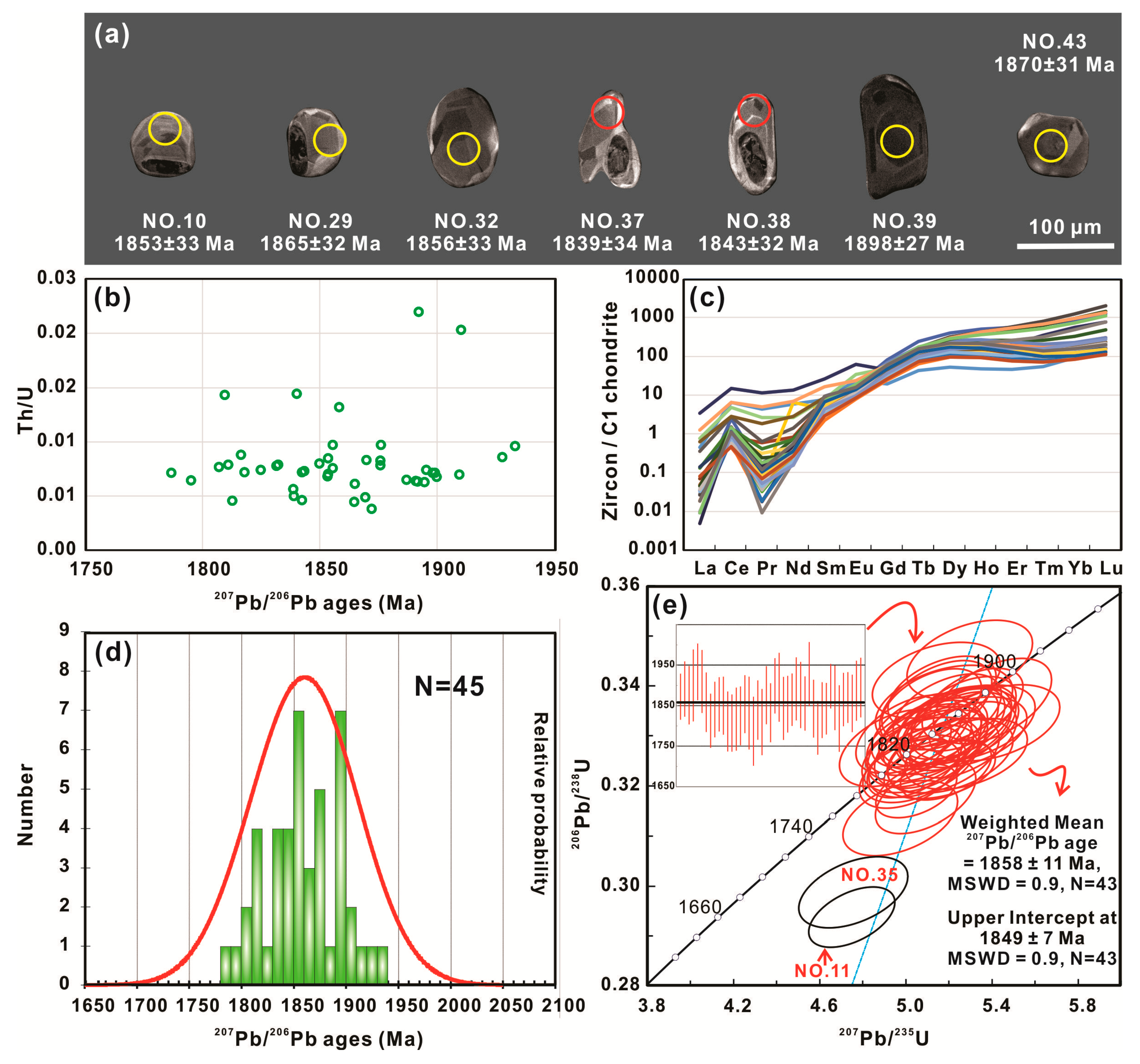
© 2019 by the authors. Licensee MDPI, Basel, Switzerland. This article is an open access article distributed under the terms and conditions of the Creative Commons Attribution (CC BY) license (http://creativecommons.org/licenses/by/4.0/).
Share and Cite
Xiao, L.-L.; Chen, M.-H. Metamorphic Age Comparison and Its Implications between the Zuoquan and Zanhuang Complexes in the Central North China Craton, Based on LA-ICP-MS Zircon U–Pb Dating. Minerals 2019, 9, 780. https://doi.org/10.3390/min9120780
Xiao L-L, Chen M-H. Metamorphic Age Comparison and Its Implications between the Zuoquan and Zanhuang Complexes in the Central North China Craton, Based on LA-ICP-MS Zircon U–Pb Dating. Minerals. 2019; 9(12):780. https://doi.org/10.3390/min9120780
Chicago/Turabian StyleXiao, Ling-Ling, and Min-Hua Chen. 2019. "Metamorphic Age Comparison and Its Implications between the Zuoquan and Zanhuang Complexes in the Central North China Craton, Based on LA-ICP-MS Zircon U–Pb Dating" Minerals 9, no. 12: 780. https://doi.org/10.3390/min9120780
APA StyleXiao, L.-L., & Chen, M.-H. (2019). Metamorphic Age Comparison and Its Implications between the Zuoquan and Zanhuang Complexes in the Central North China Craton, Based on LA-ICP-MS Zircon U–Pb Dating. Minerals, 9(12), 780. https://doi.org/10.3390/min9120780



